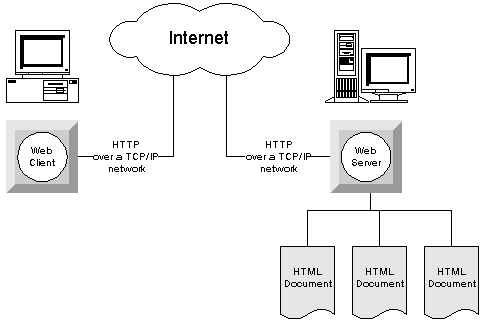

Chapter 3 Introduction to PowerDynamo
If you are already familiar with the terms TCP/IP, HTTP, Web servers, Web clients, HTML, URL, Intranet, and Internet, and you know how information is stored and transmitted over the Web, you don't need to read this section.

On the Web, information is stored at Web sites. Access to the information at a Web site is managed by a Web server for the site. Users access the information using a Web client, which is also called a browser.
Information on the Web is stored in documents, using a language named HTML (HyperText Markup Language). Web clients interpret HTML and display the documents to a user. The protocol that governs the exchange of information between the Web server and Web client is named HTTP (HyperText Transfer Protocol).
To move from one page of a document to another page, or to another document on the same or another Web site, the user clicks a link in the document shown in their Web client. Documents and locations within documents are identified by an address that is called a Uniform Resource Locator, or URL. This is an example of a URL:
http://www.sybase.com/products
URLs contain information about which server the document is on, and may also specify a particular document available to that server, and even a position within the document. In addition, a URL may carry other information from a Web client to a Web server, including the values entered into fields in an HTML form.
For more information about URLs and addresses on the Web, see the material on the World Wide Web Consortium pages, at the following address:
http://www.w3.org/pub/WWW/Addressing/
When a user clicks a link in a document on their Web client, the URL is sent to the server of the indicated Web site. The Web server locates the document, and sends the HTML across the network to the Web client.
HTML documents can reference external files (for example, a GIF or JPEG file for a graphic). Not all these external formats are supported by all Web clients. When the document contains such data, the Web client can send a request to the Web server to provide the relevant graphic. If the Web client does not support the format, it does not request the information from the server.
In a file-based Web site, each document is a separate file. For large Web sites, this leads to management problems. For example, maintaining current copies of hundreds or thousands of different resources in separate files is difficult enough; maintaining the links between these resources is even more challenging.
Another problem is that many Web sites contain dynamic information - pricing information, for example, or employee information on an organization's intranet. Maintaining such information in HTML files in addition to the database where it resides is a huge task.
For these and other reasons, linking databases to the Web is increasingly the solution of choice for management of large Web sites and management of dynamic content. Database storage of Web information can either replace or complement file storage of Web resources.
| Copyright © 2000 Sybase, Inc. All rights reserved. |

| |